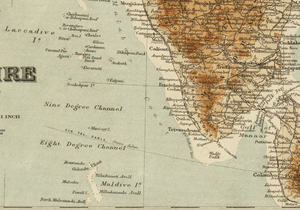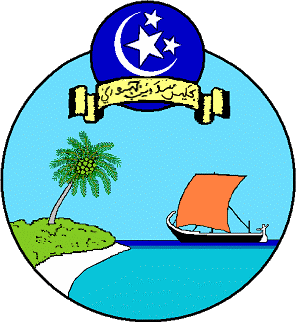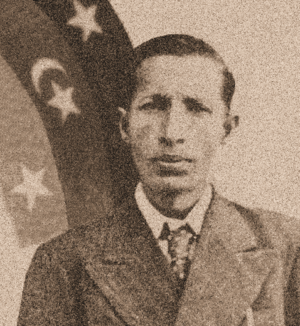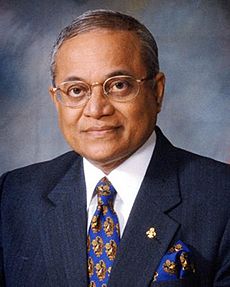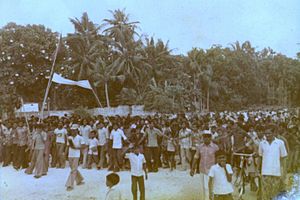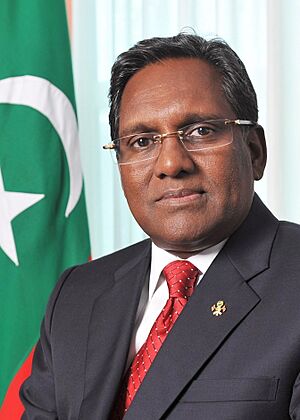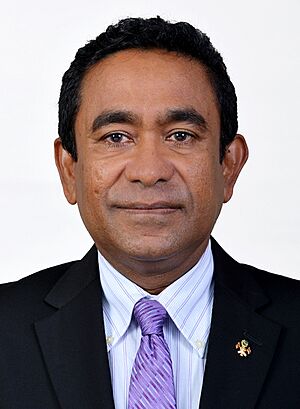President of the Maldives facts for kids
Quick facts for kids President of the Maldives |
|
|---|---|

Presidential flag
|
|
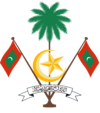
Presidential seal
|
|
| Executive branch of the Maldivian Government | |
| Style | |
| Member of | Cabinet |
| Residence | Muliaage |
| Seat | The President's Office |
| Appointer | Popular vote |
| Term length | Five years,
renewable once
|
| Constituting instrument | Constitution of the Maldives (1932) |
| Formation |
|
| First holder | Mohamed Amin Didi |
| Deputy | Vice-President |
| Salary | MVR 120,000/US$7,818 monthly ($93,816 yearly) |
The President of the Republic of Maldives (Dhivehi: ދިވެހިރާއްޖޭގެ ރައީސުލްޖުމްހޫރިއްޔާ) is the main leader of the Maldives. This person is both the head of state (the country's symbolic leader) and the head of government (the one who runs the country day-to-day). They are also the commander-in-chief of the Maldives National Defence Force, which is the country's military.
The current president is Mohamed Muizzu. He was chosen in the 2023 Maldivian presidential election with over half the votes. He won against the previous president, Ibrahim Mohamed Solih.
Contents
Understanding the Constitution
The Constitution of the Maldives is like a rulebook for the country. It explains the rights and duties of all citizens. It also sets up how the government of the Maldives works. The current constitution was approved on August 7, 2008. It replaced an older version from 1998. This constitution is often called the "Constitution of the Maldives, 2008".
A Look at History
Early Constitutions and First Republic
The Maldives got its first written constitution in 1932. This was during the time of Sultan Muhammad Shamsuddeen III. It was created with advice from Bernard H. Bourdill, who was a governor in Ceylon (now Sri Lanka).
Soon after, in 1934, a second constitution was made. More changes happened over the years. In 1940, the idea of a constitution was stopped for a short time. But it came back in 1942 with a new one.
After more changes, the Maldives became a republic in 1953. This meant it had a president instead of a sultan. The first president was Mohamed Amin Didi. A new constitution was made for this republic. However, the republic only lasted 8 months. The country went back to being a sultanate under Sultan Muhammad Fareed Didi. This led to even more constitutions in 1954, 1964, and 1967.
The Second Republic Begins
The Maldives became a republic again on November 11, 1968. This is known as the Second Republic. The new president, Ibrahim Nasir, approved a new constitution. This constitution was updated a few times in the 1970s.
Later, under President Maumoon Abdul Gayyoom, a new constitution was introduced in 1998. The government said this change would help people live together in friendship and respect.
In June 2008, a special group called the "Special Majlis" finished writing a brand new constitution. President Gayyoom approved it on August 7, 2008. This constitution took four years to write. It started after some public unrest in 2003. President Gayyoom had promised a new, more modern and democratic system for the country.
This new constitution brought important changes. It created an independent group to run the courts. It also set up independent groups to watch over elections and fight corruption. The new constitution also gave less power to the president and more power to the parliament.
Key Parts of the Constitution
The constitution has an introduction, fourteen chapters, and three extra parts called schedules. Each part focuses on a different topic.
Main Chapters
- Chapter 1 – About the State, its Power, and Citizens
- Chapter 2 – Basic Rights and Freedoms for everyone
- Chapter 3 – The People's Majlis (the parliament)
- Chapter 4 – The President's role
- Chapter 5 – The Cabinet of Ministries (government departments)
- Chapter 6 – The Judiciary (the court system)
- Chapter 7 – Independent Commissions and Offices (groups that work on their own)
- Chapter 8 – How local areas are managed
- Chapter 9 – Security Services (like police and military)
- Chapter 10 – Government Property, Debts, and Legal Actions
- Chapter 11 – What happens during a State of Emergency
- Chapter 12 – How the Constitution can be changed
- Chapter 13 – How the Constitution is used and understood
- Chapter 14 – Rules for changing from old laws to new ones
Important Schedules
- Schedule 1 – Oaths of Office (promises made by officials)
- Schedule 2 – Administrative Divisions (how the country is divided)
- Schedule 3 – The National Flag
How Elections Work
The Maldives holds national elections to choose its president and its parliament. The president is chosen directly by the people for a five-year term.
The Assembly (also called the Majlis) has 93 members. These members are also chosen directly by the people for a five-year term. Each member represents a different area of the country.
British Presence and Suvadive Republic
In the 1950s, the United Kingdom got permission to use an airfield called RAF Gan in the southern part of the Maldives. This airfield provided jobs for many local people. The Maldives allowed the British to use Gan for 100 years.
However, in 1957, the new prime minister, Ibrahim Nasir, wanted to change this agreement. He wanted a shorter lease and more money for the Maldives. In 1959, some people in the southern islands, who benefited from the British presence, decided to break away. They formed their own independent state called the United Suvadive Republic. Abdullah Afeef was their president.
The British government first showed some support for this new state. But in 1961, they signed a treaty with the main Maldives government instead. This meant the Suvadive Republic faced economic problems. In 1962, Prime Minister Nasir sent boats with police to stop the breakaway movement. The Suvadive Republic ended in 1963, and Abdullah Afeef went to live in the Seychelles.
Meanwhile, in 1960, the Maldives had agreed to let the United Kingdom keep using the Gan airfield for thirty more years. The British paid a large sum of money for this. The base finally closed in 1976.
Gaining Independence
On July 26, 1965, the Maldives became fully independent from the United Kingdom. Even though it was independent, the British government still used the Gan airfield for a while.
In March 1968, the people of the Maldives voted in a national vote. They decided to get rid of the sultanate and become a republic. This new republic was officially declared on November 11, 1968.
The agreement for independence was signed in Colombo. After this, the sultanate continued for three more years under Muhammad Fareed Didi, who called himself King.
On November 15, 1967, the parliament voted on whether to stay a monarchy or become a republic. Most members voted for a republic. Then, on March 15, 1968, the public voted, and over 81% chose to become a republic. So, on November 11, 1968, the 853-year-old monarchy ended. Ibrahim Nasir, who was the prime minister, became the first president of the new republic.
Nasir's Time as President
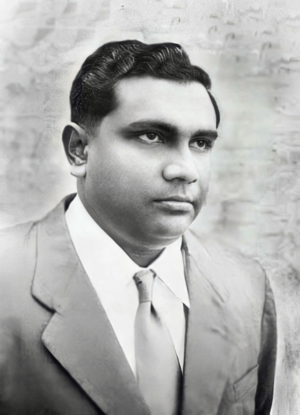
The Second Republic started in November 1968 with Ibrahim Nasir as president. He was chosen by the Majlis (parliament) and then approved by the people. He appointed Ahmed Zaki as his prime minister.
In 1973, Nasir was chosen for a second term. However, in March 1975, Prime Minister Zaki was removed from his position. Some people thought Zaki was becoming too popular.
During the 1970s, the Maldives faced economic challenges. The market for dried fish, a main export, became difficult. Also, the British closed their airfield on Gan in 1975, which hurt the economy. Nasir's time as president ended in 1978 when he left for Singapore.
Nasir is remembered for bringing many modern changes to the Maldives. He built the first international airport (Malé International Airport, 1966) and helped the Maldives join the United Nations. He also improved the fishing industry and started the tourism industry. These are now very important for the Maldivian economy.
He also introduced English-based education in schools and gave women the right to vote in 1964. He brought television and radio to the country. He also stopped a tax called Vaaru that people on islands outside Malé had to pay.
Tourism in the Maldives began to grow in the early 1970s. The first resort, Kurumba Maldives, opened in October 1972. In 1977, the country's population was counted at about 142,832 people.
Nasir was also criticized for his strong leadership style. He was also criticized for changing the local Thaana script to the Latin alphabet in 1976. This change made it hard for many people to read and write overnight. The original Tāna script was brought back by President Gayoom later.
Maumoon's Time as President
When Ibrahim Nasir's time as president was ending, he decided not to run again. The Majlis chose Maumoon Abdul Gayoom as the only candidate. Five months later, in 1978, he was elected president with a very high percentage of votes. He was re-elected five more times. His presidency brought a time of stability and economic growth. In 1978, the Maldives joined important international groups like the International Monetary Fund and the World Bank. Tourism also became much more important, with many visitors coming to the islands.
In 1982, the Maldives joined the Commonwealth of Nations.
There were a few attempts to overthrow Maumoon's government in the 1980s. The most serious was in November 1988. About 80 armed people landed in Malé. The plan failed, and the attackers left. Soon after, the Indian military arrived to help. Some people died in the fighting.
Despite these attempts, Maumoon served many more terms as president. He was re-elected with over 90% of the votes in 1983, 1988, and 1993.
Nasheed's Time as President
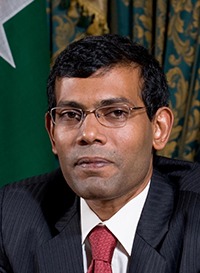
After Maumoon Abdul Gayoom's long presidency, the Maldives held its first democratic elections. Mohamed Nasheed, an activist, won with 54% of the votes. Nasheed famously held the world's first underwater cabinet meeting to highlight climate change. His time as president faced political challenges. In 2010, his entire cabinet resigned. In January 2012, Nasheed ordered the arrest of a judge. This led to a major political crisis and his resignation.
Waheed's Time as President
Mohamed Waheed Hassan Manik, who was Nasheed's vice-president, became president after Nasheed resigned on February 7, 2012. A special group was set up to investigate what happened that day. Their report said that the change of power was legal and that Nasheed's resignation was his own choice. This report was supported by many international organizations.
Yameen's Time as President
After the 2013 Maldivian presidential election, Abdulla Yameen Abdul Gayoom became the new president. In 2015, former president Mohamed Nasheed was found guilty of certain charges and sentenced to prison. He later went to the UK and received asylum.
During Yameen's presidency, there were changes in the vice-president role. In 2015, his first vice-president was removed. Then, Ahmed Adeeb Abdul Ghafoor became vice-president but was also removed later. In 2016, Abdulla Jihad was appointed as the third Vice-President.
In 2016, a report by Al Jazeera talked about some issues with corruption. In 2018, Yameen opened the Sinamalé Bridge, which connects Malé, Velana International Airport, and Hulhumalé. This bridge was built with help from the Chinese government. The Maldives also left The Commonwealth during this time.
Yameen's presidency also faced a political crisis. He declared a state of emergency. During this time, some political rivals were arrested.
Solih's Time as President

Abdulla Yameen's presidency ended after he lost the 2018 Maldivian presidential election. Ibrahim Mohamed Solih (Ibu) won the election. In 2020, the Maldives re-joined the Commonwealth.
Solih's government worked to increase the use of renewable energy, like solar power. New hospitals were built and old ones were improved. Solih also announced plans for the Thilamalé Bridge, which aims to connect several islands.
Muizzu's Time as President
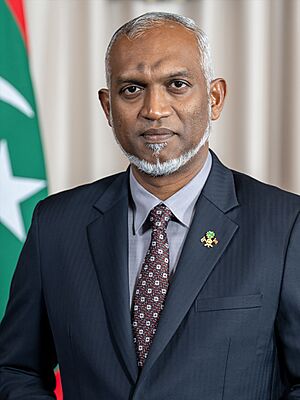
Ibrahim Mohamed Solih's term ended after he was defeated in the 2023 Maldivian presidential election. Mohamed Muizzu, a politician and engineer, won the election.
Early in 2024, Muizzu's government faced some challenges in its relationship with India. This happened after some government officials made comments about the Indian Prime Minister. This led to some people in India choosing not to visit the Maldives.
List of Presidents
More to Explore
- List of Maldivian presidents by age
- Politics of the Maldives
- History of the Maldives
- List of sultans of the Maldives
- List of head of state of the Maldives
- First family of the Maldives
- Prime Minister of the Maldives
- Vice-President of the Maldives
- First Lady of the Maldives
- Second Lady of the Maldives
See also
 In Spanish: Anexo:Presidentes de las Maldivas para niños
In Spanish: Anexo:Presidentes de las Maldivas para niños


